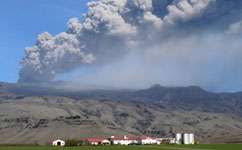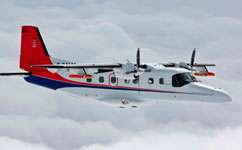A new online tool for predicting the amount of ash pumped into the atmosphere during a volcanic eruption has been made openly available to scientists around the world.
PlumeRise, created by researchers at the University of Bristol, will allow forecasters to more accurately predict the spread of volcanic ash clouds, paving the way for better management of airspace during volcanic crises.
It has already revealed that the 2010 eruption of Iceland's Eyjafjallajökull volcano, which grounded planes and cancelled Easter holiday plans across Europe, may have unleashed up to 10 times more ash than originally thought.
'Our research represents an important development in our modelling of volcanic plumes,' says Dr Mark Woodhouse, one of the creators of PlumeRise, and lead author on the original study.
'This model can complement the state-of-the-art forecasting tools used to predict the spread of ash during volcanic crises.'
Before now, estimates of the amount of ash released by an eruption have relied solely on measurements of the height of the volcanic plume. But that approach is only reliable in still air.
To take account of the effects of the wind, mathematicians and Earth scientists at the University of Bristol have combined their expertise to create a new mathematical model.
NERC's Dornier 228 aircraft, which flew into the ash cloud throughout the 2010 eruption, gathering vital data for forecasters on the ground.
The model shows that strong winds prevent ash plumes from reaching as high as they would in calm conditions. This means that ash estimates that rely on plume-height measurements alone can dramatically undershoot the real figure.
Now the team have taken their research one step further, creating an online tool that could be used by scientists around the world to predict and monitor just how much ash is released during an eruption.
That information can then be fed into forecasts to give a more reliable prediction of how an ash cloud will spread, and how airspace will need to be managed accordingly.
'The amount of ash released during an eruption, and the rate at which is injected into the atmosphere, is an important input into meteorological simulations of ash cloud dispersal,' says Dr Jeremy Phillips, co-creator of PlumeRise.
'It is used directly by the Volcanic Ash Advisory Centres to provide information to the airline industry.'
'We're making this openly and freely available as a web-based tool to anybody who wants to use it.'
PlumeRise has been tested by several of the Volcanic Ash Advisory Centres (VAACs) around the world including the Met Office London VAAC which covers the UK, Iceland and the north-eastern part of the North Atlantic Ocean.
It is also being used by academic institutions in Japan, the Istituto Nazionale di Geofisica e Vulcanologia in Italy, and the Icelandic Meteorological Office.
More information: Woodhouse, M. et al. Interaction between volcanic plumes and wind during the 2010 Eyjafjallajokull eruption, Iceland, 2013, Journal of Geophysical Research. DOI: 10.1029/2012JB009592
Journal information: Journal of Geophysical Research
Provided by PlanetEarth Online
This story is republished courtesy of Planet Earth online, a free, companion website to the award-winning magazine Planet Earth published and funded by the Natural Environment Research Council (NERC).


.jpg)


















